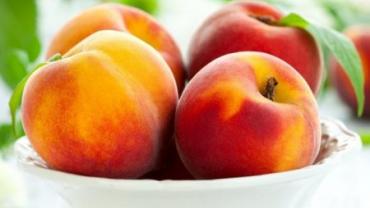
Nothing says summer like biting into a soft ripe peach with its sweet juices running down your chin. Although fresh peaches are sometimes available at other times of year their texture may be mealy and the flavor bland. Summertime farmers’ markets offer peaches that are incomparably delicious. But peaches aren’t just a treat for the palate. As a whole unprocessed food they’re also a great snack and a flavorful ingredient in sweet and savory recipes alike.
Like most fruit peaches have a very low glycemic index partly due to the fructose content. Fructose is a type of sugar that does not affect blood sugar as much as glucose and sucrose do. Health-conscious consumers are watching fructose intake more these days as concerns about the effects of fructose on liver health have been discussed in popular media. However the large amounts of fructose provided in sodas and fruit juices may have different effects on the body than the small amounts of fructose present in whole foods—especially when this fructose is accompanied by all the wonderful nutrients naturally occurring in whole fruit.
Ounce for ounce peaches contain less fructose than apples and bananas. Peaches are a good source of beta-carotene and vitamin C and of course eaten in whole form (as opposed to juice or nectar) they contain fiber which may help increase satiety.
Peaches are included in the Environmental Working Group’s “Dirty Dozen” – the produce items that contain the highest pesticide loads. But reducing the body’s overall pesticide load is only one reason to choose organic produce. Researchers who evaluated differences between organically grown and conventionally grown peaches found that the organic peaches had higher levels of citric and ascorbic acids and total polyphenols. It is believed that these antioxidant nutrients are part of the plants’ natural defense systems. With fewer or no synthetic pesticides to protect them organic fruits must produce more of their own protective substances.
Some people might find the fuzz of peach skin slightly off-putting but don’t toss the skin! Peach skin contributes significantly to the total nutrient content of the fruit. Among the different varieties of peaches peaches with redder flesh have a higher anthocyanin content and total anthocyanins are higher when the skin is included in evaluations compared to when only the flesh is analyzed. Researchers have found that 70% of peach phenolic compounds are found in the skin with just 30% in the flesh. (For people eating the skin of fruits and vegetables purchasing organic may be especially important.)
The common advice to consume brightly colored vegetables and fruit seems to be accurate when it comes to peaches. The vitamin C content of white peaches is approximately 6-9mg/100g compared to 4-13mg/100g for yellow peaches. The difference in total carotenoid concentration is even more telling with 7-20mcg/100g for white peaches and 71-210mcg/100g for yellow peaches. (But don’t be misled into thinking white peaches are a waste of your time. They too can be very good for you!)
Usually called a “stone fruit” by botanical classification peaches are drupes—a category that also contains apricots plums cherries and olives. The outermost layer—which we call the skin—is the exocarp. The fleshy part of the fruit which is the sweet juicy part is called the mesocarp. Inside the middle of the mesocarp is the pit or endocarp and inside the endocarp is the seed. In cutting or biting into a peach you may notice whitish bits on the pit and possibly on the flesh immediately near the pit. This is not a fungus or bacteria and it is safe to eat.
While peaches are excellent summertime snacks all on their own they make wonderful additions to salads especially when paired with peppery greens such as arugula and watercress where the sweetness helps to offset the bitterness of the greens. Grilled peaches make a tasty dessert often paired with plain yogurt vanilla ice cream or even a thick aged balsamic vinegar. Peaches are also a great addition to savory meals and are classic for pairing with pork.
Sources